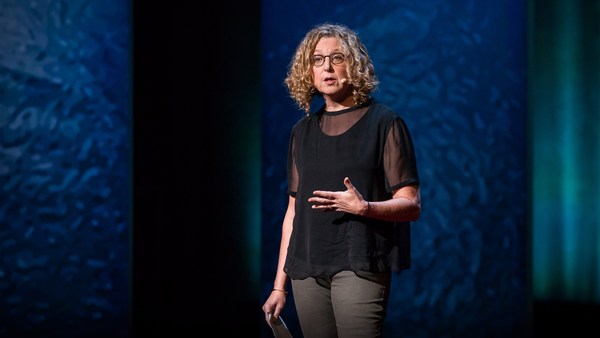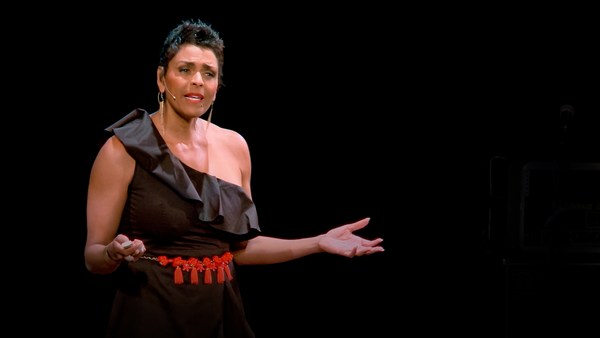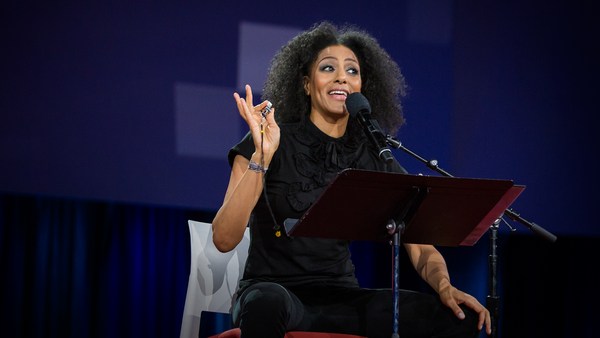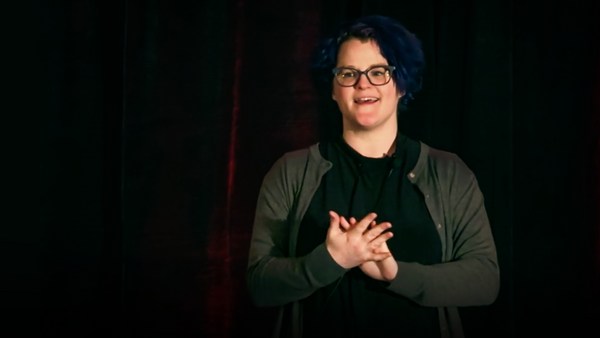[This talk contains mature content] Six years ago, I discovered something that scientists have been wanting to know for years. How do you capture the attention of a roomful of extremely bored teenagers? It turns out all you have to do is mention the word pornography.
(Laughter)
Let me tell you how I first learned this. In 2012, I was sitting in a crowded room full of high school students who were attending an after-school program in Boston. And my job, as guest speaker for the day, was to inspire them to think about how exciting it would be to have a career in public health. The problem was, as I looked at their faces, I could see that their eyes were glazing over, and they were just tuning out. It didn't even matter that I wore what I thought was my cool outfit that day. I was just losing my audience. So, then one of the two adults who worked for the program said, "Aren't you doing some research about pornography? Maybe tell them about that." All of a sudden, that room full of high school students exploded into laughter, high fives. I think there were some loud hooting noises. And all anyone had done was say that one word -- pornography. That moment would prove to be an important turning point for me and my professional mission of finding solutions to end dating and sexual violence.
At that point, I'd been working for more than a decade on this seemingly intractable problem of dating violence. Data from the US Centers for Disease Control and Prevention demonstrate that one in five high school-attending youth experience physical and/or sexual abuse by a dating partner each year in the US. That makes dating violence more prevalent than being bullied on school property, seriously considering suicide, or even vaping, in that same population. But solutions were proving elusive. And I was working with a research team that was hunting for novel answers to the question: What's causing dating abuse, and how do we stop it? One of the research studies that we were working on at the time happened to include a few questions about pornography. And something unexpected was emerging from our findings. Eleven percent of the teen girls in our sample reported that they had been forced or threatened to do sexual things that the perpetrator saw in pornography. That got me curious.
Was pornography to blame for any percentage of dating violence? Or was it more like a coincidence that the pornography users also happen to be more likely to be in unhealthy relationships? I investigated by reading everything that I could from the peer-reviewed literature, and by conducting my own research. I wanted to know what kinds of sexually explicit media youth were watching, and how often and why, and see if I could piece together if it was part of the reason that for so many of them dating relationships were apparently unhealthy.
As I read, I tried to keep an open mind, even though there were plenty of members of the public who'd already made up their mind about the issue. Why would I keep an open mind about pornography? Well, I'm a trained social scientist, so it's my job to be objective. But I'm also what people call sex-positive. That means that I fully support people's right to enjoy whatever kind of sex life and sexuality they find fulfilling, no matter what it involves, as long as it includes the enthusiastic consent of all parties involved. That said, I personally wasn't inclined towards watching pornography. I'd seen some, didn't really do anything for me. And as a mom of two soon-to-be teenage children, I had my own concerns about what seeing pornography could do to them.
I noticed that while there were a lot of people who were denouncing pornography, there were also people who were staunch defenders of it for a variety of reasons. So in my scholarly exploration, I genuinely tried to understand: Was pornography bad for you or was it good for you? Was it misogynist or was it empowering? And there was not one singular answer that emerged clearly. There was one longitudinal study that had me really worried, that showed that teenagers who saw pornography were subsequently more likely to perpetrate sexual violence. But the design of the study didn't allow for definitive causal conclusions. And there were other studies that did not find that adolescent pornography use was associated with certain negative outcomes. Even though there were other studies that did find that.
But as I spoke to other experts, I felt tremendous pressure to pick a side about pornography. Join one team or the other. I was even told that it was weak-minded of me not to be able to pick out the one correct answer about pornography. And it was complicated, because there is an industry that is capitalizing off of audience's fascination with seeing women, in particular, not just having sex, but being chocked, gagged, slapped, spit upon, ejaculated upon, called degrading names over and over during sex, and not always clearly with their consent. Most people would agree that we have a serious problem with misogyny, sexual violence and rape in this country, and pornography probably isn't helping with any of that. And a critically important problem to me was that for more than a century, the anti-pornography position had been used as a pretext for discriminating against gays and lesbians or people who have kinks or have fetishes. So I could see why, on the one hand, we might be very worried about the messages that pornography is sending, and on the other hand, why we might be really worried about going overboard indicting it.
For the next two years, I looked into every scary, horrifying claim that I could find about the average age at which people first see pornography, or what it does to their brains or their sexuality. Here's what I have to report back. The free, online, mainstream pornography, that's the kind that teenagers are most likely to see, is a completely terrible form of sex education.
(Laughter)
(Applause)
But that's not what it was intended for. And it probably is not instantly poisoning their minds or turning them into compulsive users, the way that some ideologues would have you believe. It's a rare person who doesn't see some pornography in their youth. By the time they're 18 years old, 93 percent of first year college males and 62 percent of females have seen pornography at least once. And though people like to say that the internet has made pornography ubiquitous, or basically guarantees that any young child who's handed a smartphone is definitely going to see pornography, data don't really support that. A nationally representative study found that in the year 2000 16 percent of 10-to-13-year-old youth reported that they'd seen pornography in the past year. And by 2010, that figure had increased. But only to 30 percent. So it wasn't everybody.
Our problems with adolescents and sexual violence perpetration is not only because of pornography. In fact, a recent study found that adolescents are more likely to see sexualized images in other kinds of media besides pornography. Think about all those sexualized video games, or TV shows, or music videos. And it could be exposure to a steady stream of violent media that instead of or in addition to the sexualized images is causing our problems. By focusing on the potential harms of pornography alone, we may be distracting ourselves from bigger issues. Or missing root causes of dating and sexual violence, which are the true public health crises.
That said, even my own research demonstrates that adolescents are turning to pornography for education and information about sex. And that's because they can't find reliable and factual information elsewhere. Less than 50 percent of the states in the United States require that sex education be taught in schools, including how to prevent coerced sex. And less than half of those states require that the information presented be medically accurate.
So in that Boston after-school program, those kids really wanted to talk about sex, and they really wanted to talk about pornography. And they wanted to talk about those things a whole lot more than they wanted to talk about dating or sexual violence. So we realized, we could cover all of the same topics that we might normally talk about under the guise of healthy relationships education, like, what's a definition of sexual consent? Or, how do you know if you're hurting somebody during sex? Or what are healthy boundaries to have when you're flirting? All of these same things we could discuss by using pornography as the jumping-off point for our conversation. It's sort of like when adults give kids a desert like brownies, but they secretly baked a zucchini or something healthy inside of it.
(Laughter)
We could talk to the kids about the healthy stuff, the stuff that's good for you, but hide it inside a conversation that was about something that they thought they wanted to be talking about. We also discovered something that we didn't necessarily set out to find, which is that there's a fantastic way to have a conversation with teenagers about pornography. And that is, keep the conversation true to science. Admit what we know and what we don't know about the impact of pornography. Talk about where there are mixed results or where there are weaknesses in the studies that have been conducted. Invite the adolescents to become critical consumers of the research literature on pornography, as well as the pornography itself. That really fits with adolescent development. Adolescents like to question things and they like to be invited to think for themselves.
And we realized by starting to experiment, teaching some classes in consent, respect and pornography, that trying to scare adolescents into a particular point of view or jam a one-sided argument down their throat about pornography not only probably does not work, but really doesn't model the kind of respectful, consensual behavior that we want them to learn. So our approach, what we call pornography literacy, is about presenting the truth about pornography to the best of our knowledge, given that there is an ever-changing evidence base. When people hear that we teach a nine-session, 18-hour class in pornography literacy to teenagers, I think that they either think that we're sitting kids down and trying to show them how to watch pornography, which is not what we do, or that we're part of an anti-pornography activist group that's trying to convince them that if they ever saw pornography, it would be the number one worst thing for their health ever. And that's not it, either.
Our secret ingredient is that we're nonjudgmental. We don't think that youth should be watching pornography. But, above all, we want them to become critical thinkers if and when they do see it. And we've learned, from the number of requests for our curriculum and our training, from across the US and beyond, that there are a lot of parents and a lot of teachers who really do want to be having these more nuanced and realistic conversations with teenagers about pornography. We've had requests from Utah to Vermont, to Alabama, to Hawaii.
So in that after-school program, what I saw, is that from the minute we mentioned the word pornography, those kids were ready to jump in to a back-and-forth about what they did and didn't want to see in pornography, and what they did and didn't want to do during sex. And what was degrading to women or unfair to men or racist, all of it. And they made some really sophisticated points. Exactly the kinds of things that we would want them to be talking about as violence prevention activists.
And as teachers, we might leave the class one day and think, "It is really sad that there's that one boy in our class who thinks that all women have orgasms from anal sex." And we might leave class the next week and think, "I'm really glad that there's that one kid in our class who's gay, who said that seeing his sexuality represented in pornography saved his life." Or, "There's that one girl in our class who said that she's feeling a lot better about her body, because she saw someone shaped like her as the object of desire in some tame pornography."
So this is where I find myself as a violence prevention activist. I find myself talking about and researching pornography. And though it would be easier if things in life were all one way or the other, what I've found in my conversations with teenagers about pornography is that they remain engaged in these conversations because we allow them to grapple with the complexities. And because we're honest about the science. These adolescents may not be adults yet, but they are living in an adult world. And they're ready for adult conversations.
Thank you.
(Applause)





